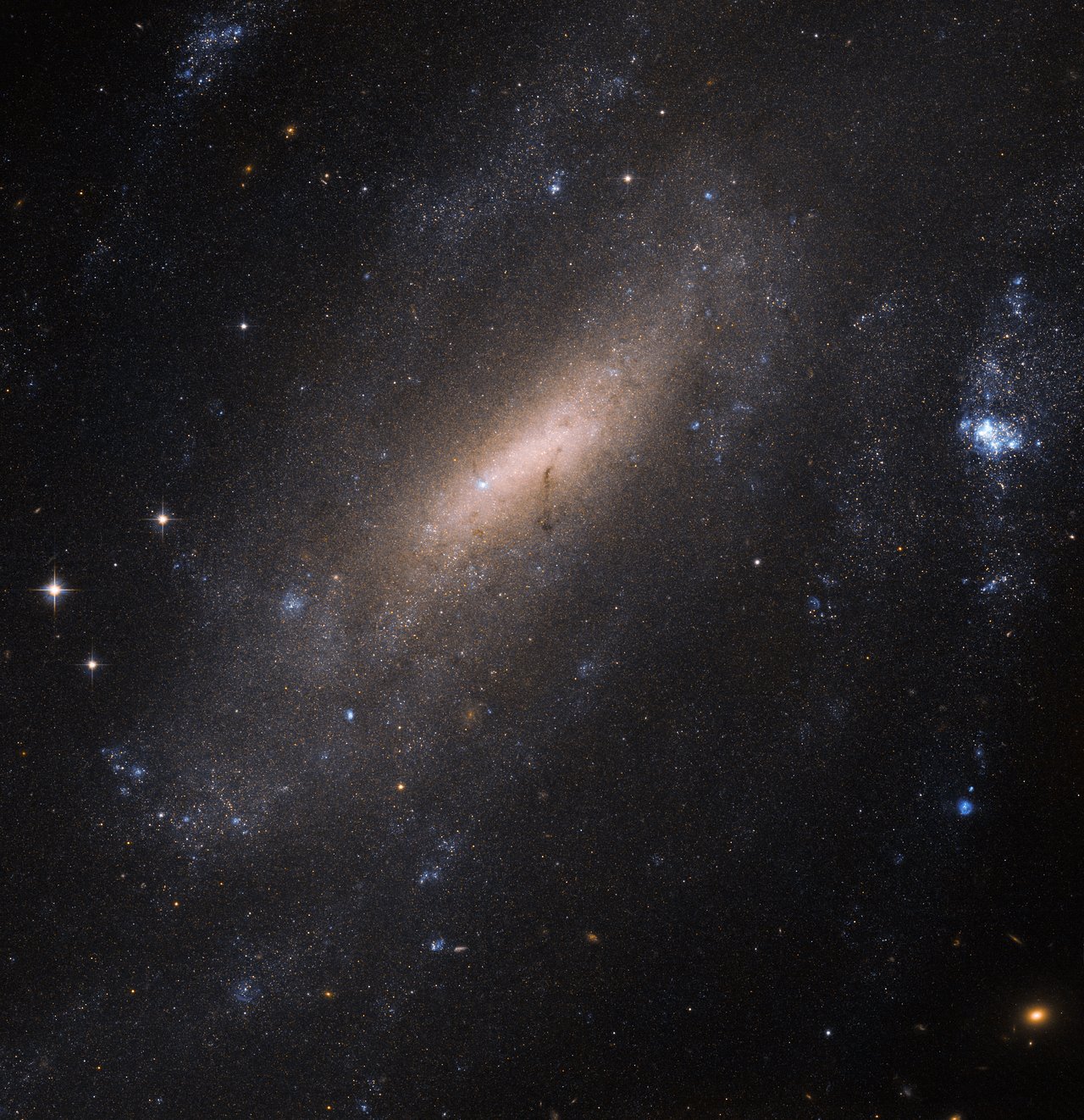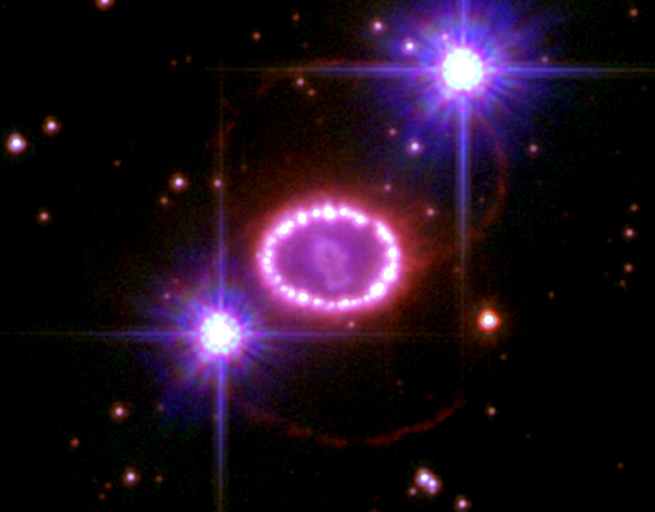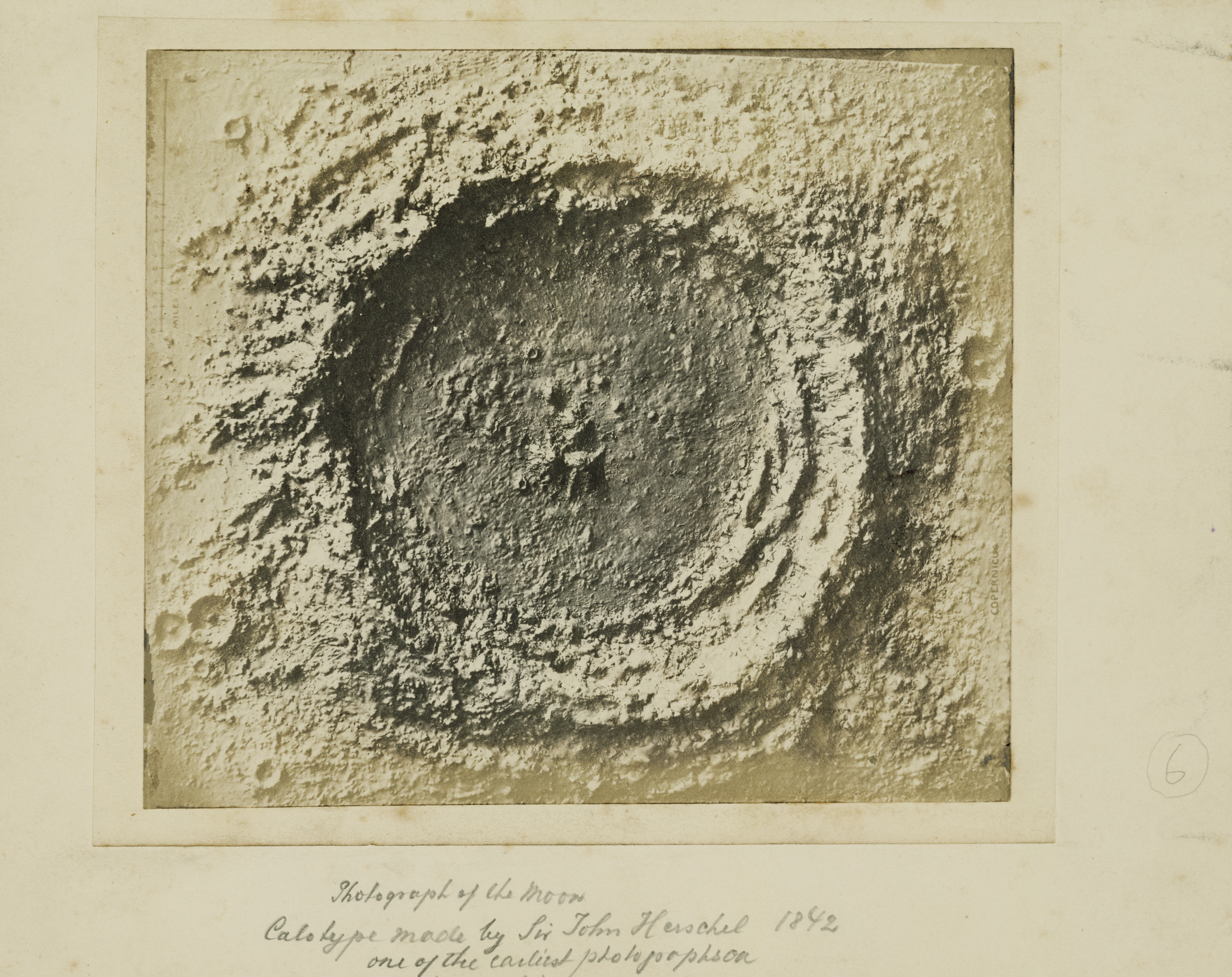|
NGC 1300
NGC 1300 is a barred spiral galaxy located about 61 million light-years away in the constellation Eridanus. The galaxy is about 110,000 light-years across. It is a member of the Eridanus Cluster, a cluster of 200 galaxies. It was discovered by John Herschel in 1835. Nucleus In the core of the larger spiral structure of NGC 1300, the nucleus shows a " grand-design" spiral structure that is about 3,300 light-years long. Only galaxies with large-scale bars appear to have these grand-design inner disks — a spiral within a spiral. Models suggest that the gas in a bar can be funneled inwards, and then spiral into the center through the grand-design disk, where it can potentially fuel a central supermassive black hole (SMBH). NGC 1300 is not known to have an active nucleus, indicating that its central black hole is not accreting matter. The SMBH has a mass of . At least one supernova has been observed in NGC 1300: SN 2022acko (type IIP, mag. 15.8). [...More Info...] [...Related Items...] OR: [Wikipedia] [Google] [Baidu] |
New General Catalogue
The ''New General Catalogue of Nebulae and Clusters of Stars'' (abbreviated NGC) is an astronomical catalogue of deep-sky objects compiled by John Louis Emil Dreyer in 1888. The NGC contains 7,840 objects, including galaxies, star clusters and emission nebulae. Dreyer published two supplements to the NGC in 1895 and 1908, known as the ''Index Catalogues'' (abbreviated IC), describing a further 5,386 astronomical objects. Thousands of these objects are best known by their NGC or IC numbers, which remain in widespread use. The NGC expanded and consolidated the cataloguing work of William and Caroline Herschel, and John Herschel's ''General Catalogue of Nebulae and Clusters of Stars''. Objects south of the celestial equator are catalogued somewhat less thoroughly, but many were included based on observation by John Herschel or James Dunlop. The NGC contained multiple errors, but attempts to eliminate them were made by the ''Revised New General Catalogue'' (RNGC) by Jack W. Sulent ... [...More Info...] [...Related Items...] OR: [Wikipedia] [Google] [Baidu] |
Grand Design Spiral Galaxy
A grand design spiral galaxy is a type of spiral galaxy with prominent and well-defined spiral arms, as opposed to multi-arm and flocculent spirals which have subtler structural features. The spiral arms of a grand design galaxy extend clearly around the galaxy through many radians and can be observed over a large fraction of the galaxy's radius. As of 2002, approximately 10 percent of all currently known spiral galaxies are classified as grand design type spirals, including M51, M74, M81, M83, and M101. Origin of structure Density wave theory is the preferred explanation for the well-defined structure of grand design spirals, first suggested by Lin and Shu in 1964. The term "grand design" was not used in this work, but appeared in the 1966 continuation paper, Lin (along with Yuan and Shu) is usually credited with coining of the term. According to the density wave theory, the spiral arms are created inside density waves that turn around the galaxy at different speeds fro ... [...More Info...] [...Related Items...] OR: [Wikipedia] [Google] [Baidu] |
NGC Objects
The ''New General Catalogue of Nebulae and Clusters of Stars'' (abbreviated NGC) is an astronomical catalogue of deep-sky objects compiled by John Louis Emil Dreyer in 1888. The NGC contains 7,840 objects, including galaxies, star clusters and emission nebulae. Dreyer published two supplements to the NGC in 1895 and 1908, known as the ''Index Catalogues'' (abbreviated IC), describing a further 5,386 astronomical objects. Thousands of these objects are best known by their NGC or IC numbers, which remain in widespread use. The NGC expanded and consolidated the cataloguing work of William and Caroline Herschel, and John Herschel's ''General Catalogue of Nebulae and Clusters of Stars''. Objects south of the celestial equator are catalogued somewhat less thoroughly, but many were included based on observation by John Herschel or James Dunlop. The NGC contained multiple errors, but attempts to eliminate them were made by the ''Revised New General Catalogue'' (RNGC) by Jack W. Sulenti ... [...More Info...] [...Related Items...] OR: [Wikipedia] [Google] [Baidu] |
Eridanus Group
The Eridanus Group, sometimes called the Eridanus Cloud, is a nearby loose grouping of galaxies at a mean distance of approximately 75 Mly (23 ± 2 Mpc) in the constellation Eridanus. Redshift values show that there are approximately 200 galaxies associated with the group, approximately 70% of which are spiral and irregular type galaxies while the remaining 30% are elliptical and lenticular types. Characteristics The concentration of galaxies in the Eridanus area was first identified by Baker in 1933. A more in depth study and discussion of the region was carried out by de Vaucouleurs in 1975. Work by Willmer et al. in 1989 suggested that the Group is condensing from the Hubble Flow and is a prominent feature in the large-scale system called the Eridanus-Fornax-Dorado Filament. The group extends over approximately 10 Mpc and on the sky is bounded by the lines of 3hr6' and 4hr30' of Right Ascension and −10° and −30° Declination. The galaxies in the Eridanus Gro ... [...More Info...] [...Related Items...] OR: [Wikipedia] [Google] [Baidu] |
Barred Spiral Galaxies
A barred spiral galaxy is a spiral galaxy with a central bar-shaped structure composed of stars. Bars are found in about two thirds of all spiral galaxies, and generally affect both the motions of stars and interstellar gas within spiral galaxies and can affect spiral arms as well. The Milky Way Galaxy, where the Solar System is located, is classified as a barred spiral galaxy. Edwin Hubble classified spiral galaxies of this type as "SB" (spiral, barred) in his Hubble sequence and arranged them into sub-categories based on how open the arms of the spiral are. SBa types feature tightly bound arms, while SBc types are at the other extreme and have loosely bound arms. SBb-type galaxies lie in between the two. SB0 is a barred lenticular galaxy. A new type, SBm, was subsequently created to describe somewhat irregular barred spirals, such as the Magellanic Clouds, which were once classified as irregular galaxies, but have since been found to contain barred spiral structures. Among othe ... [...More Info...] [...Related Items...] OR: [Wikipedia] [Google] [Baidu] |
NGC 1232
NGC 1232 is an intermediate spiral galaxy about 60 million light-years away in the constellation Eridanus. It was discovered by German-British astronomer William Herschel on 20 October 1784. It is dominated by millions of bright stars and dark dust, in spiral arms rotating about the center. Open clusters containing bright blue stars are sprinkled along these spiral arms, with dark lanes of dense interstellar dust between. Less visible are dimmer stars and interstellar gas, comprising such a high mass that they dominate the dynamics of the inner galaxy. Not visible is matter of unknown form called dark matter, needed to explain the motions of the visible material in the outer galaxy. The galaxy is approximately 200,000 light-years across, in between the sizes of the Andromeda Galaxy and our home galaxy, the Milky Way. The galaxy's spiral arms are not smooth and perturbed, leading to some suggesting a collision with a dwarf galaxy. However, some studies doubt this suggestion. NGC ... [...More Info...] [...Related Items...] OR: [Wikipedia] [Google] [Baidu] |
NGC 7479
NGC 7479 (also known as Caldwell 44 or the Superman Galaxy) is a barred spiral galaxy about 105 million light-years away in the constellation Pegasus (constellation), Pegasus. William Herschel discovered it in 1784. NGC 7479 is also recognized as a Seyfert galaxy and a Low-ionization nuclear emission-line region, LINER undergoing Starburst region, starburst activity not only on the nucleus and the outer arms, but also across the bar of the galaxy, where most of the stars were formed in the last 100 million years. Polarization studies of this galaxy indicate that it recently underwent a minor merger and that it is unique in the radio continuum, with arms opening in a direction opposite to the optical arms. This feature, along with the asymmetrical arms of the galaxy and the intense star formation activity are attributed to a merger with a smaller galaxy. This galaxy is similar in both size and morphology to the barred spiral NGC 1300. Two supernovae have been observed in NGC 7479: ... [...More Info...] [...Related Items...] OR: [Wikipedia] [Google] [Baidu] |
NGC 1672
NGC 1672 is a barred spiral galaxy located in the constellation Dorado. It was discovered by the astronomer James Dunlop on November 5, 1826. It was originally unclear whether it was a member of the Dorado Group, with some sources finding it to be a member and other sources rejecting its membership. However, recent tip of the red-giant branch (TRGB) measurements indicate that NGC 1672 is located at the same distance as other members, suggesting it is indeed a member of the Dorado Group. NGC 1672 has a large bar which is estimated to measure around 20 kpc. It has very strong radio emissions emanating from its nucleus, bar, and the inner portion of the spiral arm region. The nucleus is Seyfert type II and is engulfed by a starburst region. The strongest polarized emissions come from the northeastern region which is upstream from its dust lanes. Magnetic field lines are at large angles with respect to the bar and turn smoothly to the center. Two supernovae have been observed in NG ... [...More Info...] [...Related Items...] OR: [Wikipedia] [Google] [Baidu] |
Type II Supernova
A Type II supernova (plural: ''supernovae'' or ''supernovas'') results from the rapid collapse and violent explosion of a massive star. A star must have at least 8 times, but no more than 40 to 50 times, the mass of the Sun () to undergo this type of explosion. Type II supernovae are distinguished from other types of supernovae by the presence of hydrogen in their spectra. They are usually observed in the spiral arms of galaxies and in H II regions, but not in elliptical galaxies; those are generally composed of older, low-mass stars, with few of the young, very massive stars necessary to cause a supernova. Stars generate energy by the nuclear fusion of elements. Unlike the Sun, massive stars possess the mass needed to fuse elements that have an atomic mass greater than hydrogen and helium, albeit at increasingly higher temperatures and pressures, causing correspondingly shorter stellar life spans. The degeneracy pressure of electrons and the energy generated by th ... [...More Info...] [...Related Items...] OR: [Wikipedia] [Google] [Baidu] |
Supermassive Black Hole
A supermassive black hole (SMBH or sometimes SBH) is the largest type of black hole, with its mass being on the order of hundreds of thousands, or millions to billions of times the mass of the Sun (). Black holes are a class of astronomical objects that have undergone gravitational collapse, leaving behind spheroidal regions of space from which nothing can escape, not even light. Observational evidence indicates that almost every large galaxy has a supermassive black hole at its Central massive object, center. For example, the Milky Way has a Galactic Center#Supermassive black hole, supermassive black hole in its Galactic Center, corresponding to the Astronomical radio source, radio source Sagittarius A*. Accretion (astrophysics), Accretion of Interstellar medium, interstellar gas onto supermassive black holes is the process responsible for powering Active galactic nucleus, active galactic nuclei (AGNs) and quasars. Two supermassive black holes have been directly imaged by the ... [...More Info...] [...Related Items...] OR: [Wikipedia] [Google] [Baidu] |
Light-years
A light-year, alternatively spelled light year, is a large unit of length used to express astronomical distances and is equivalent to about 9.46 trillion kilometers (), or 5.88 trillion miles ().One trillion here is taken to be 1012 (one million million, or billion in long scale). As defined by the International Astronomical Union (IAU), a light-year is the distance that light travels in a vacuum in one Julian year (365.25 days). Because it includes the time-measurement word "year", the term ''light-year'' is sometimes misinterpreted as a unit of time. The ''light-year'' is most often used when expressing distances to stars and other distances on a galactic scale, especially in non-specialist contexts and popular science publications. The unit most commonly used in professional astronomy is the parsec (symbol: pc, about 3.26 light-years) which derives from astrometry; it is the distance at which one astronomical unit subtends an angle of one second of arc. Defini ... [...More Info...] [...Related Items...] OR: [Wikipedia] [Google] [Baidu] |
John Herschel
Sir John Frederick William Herschel, 1st Baronet (; 7 March 1792 – 11 May 1871) was an English polymath active as a mathematician, astronomer, chemist, inventor, experimental photographer who invented the blueprint and did botanical work. Herschel originated the use of the Julian day system in astronomy. He named seven moons of Saturn and four moons of Uranus – the seventh planet, discovered by his father Sir William Herschel. He made many contributions to the science of photography, and investigated colour blindness and the chemical power of ultraviolet rays. His ''Preliminary Discourse'' (1831), which advocated an inductive approach to scientific experiment and theory-building, was an important contribution to the philosophy of science. Early life and work on astronomy Herschel was born in Slough, Buckinghamshire, the son of Mary Baldwin and astronomer William Herschel. He was the nephew of astronomer Caroline Herschel. He studied shortly at Eton College an ... [...More Info...] [...Related Items...] OR: [Wikipedia] [Google] [Baidu] |





